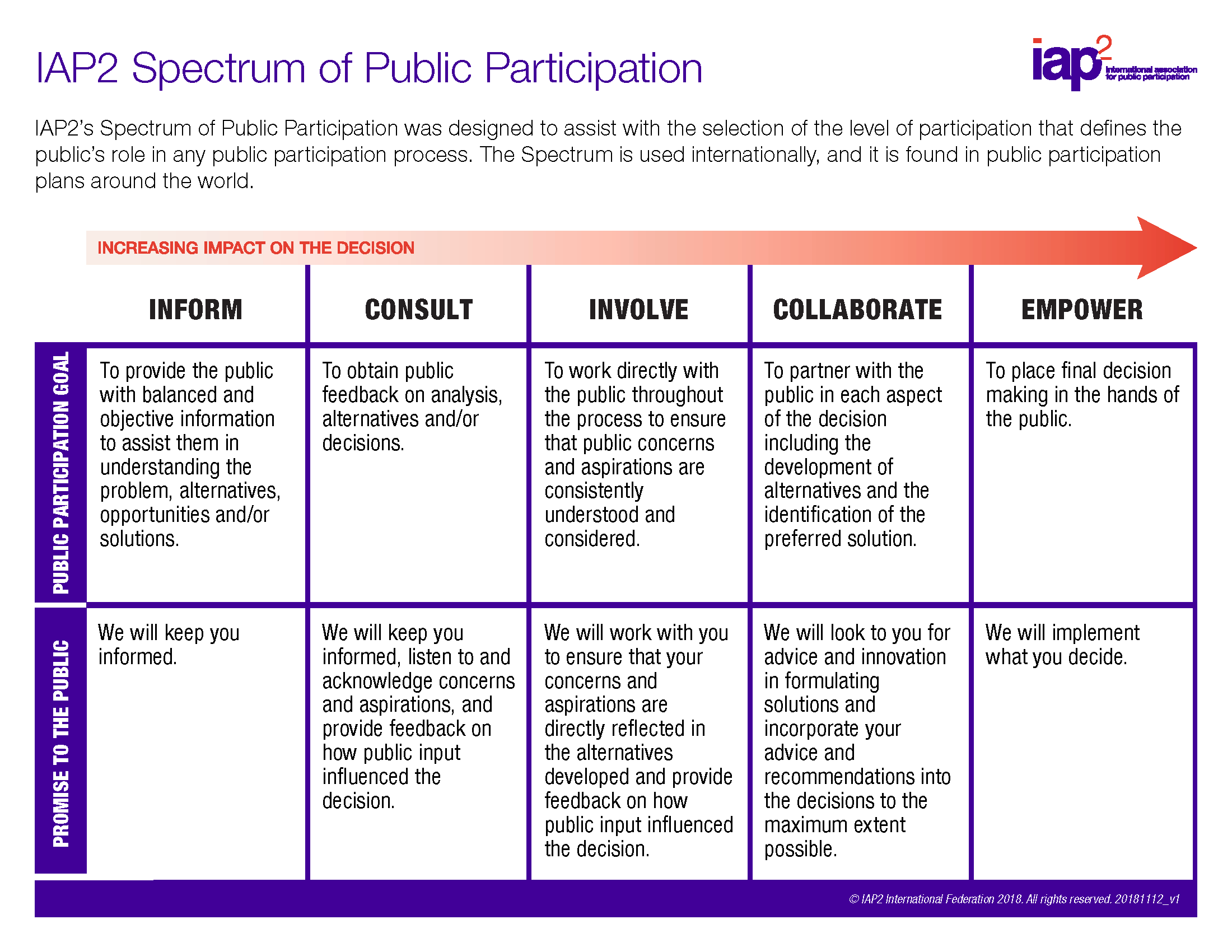Open Government for Dummies: Participation
Public participation and dialogue improve the relationship between the rulers and the ruled, strengthens democratic systems, and legitimizes governmental decisions. We review the concept and best practices.
Available in:

By Laura Tamia Ortiz Chaves. Published: July 2021.
In previous posts, we approached Open Governmenthttps://www.datasketch.co/blog/open-government/. We talked about its definition, pillars and deepened what is understood by transparency within this form of governance. In this post, we will review what citizen participation is in Open Government.
What is citizen participation?
Citizen participation is understood as the set of organizational structures, activities, processes, and techniques through which the population intervenes in public affairs that affect them (Pindado, 2008). Dialogue improves the relationship between the rulers and the ruled, strengthens democratic systems, and legitimizes governmental decisions. Citizen participation thus becomes the raison d’être of Open Government. It brings everything together. It allows the redistribution of power and the generation of policies for and with citizens. Thus, involving them not only at the beginning -through voting- and in the control of public management and, in the best scenarios, decision-making by taking advantage of their knowledge, experiences, opinions, and values.
Governments can only achieve Citizen participation through respect for the rule of law and the guarantee of compliance with fundamental human rights. We mean freedom of speech, press, assembly, petition, association, and compliance with whistleblower or opposition protection regulations, which allow people to participate without fear and discuss public affairs peacefully. Furthermore, it is essential for accurate and active participation that citizens have confidence in the institutions and that the mechanisms and information necessary for effective participation exist and are openly offered.
Most countries have regulations on participation in their national laws and have committed themselves to promote it by signing international instruments. For example, in 2001, through the Inter-American Democratic Charter, the Member States of the Organization of American States (OAS) agreed and approved that “The participation of citizens in decisions related to their development is a right and a responsibility. It is also a necessary condition for the full and effective exercise of democracy […].” Nowadays, participation through ICTs is a big bet of governments. You can know the performance of countries in the UN E-Participation Index.
However, all that glitters is not gold. Sometimes the participation spaces offered by governments do not meet expectations and become spaces to validate ideas and preconceived decisions. As a result, citizen input remains in good ideas thrown in the air, in attendance lists. Often the actors who participated get no recognition, generating what is colloquially called “participation-washing.”

How is participation categorized?
From a theoretical point of view, several proposals categorize the degrees of citizen participation in the sphere of public administration. Arnstein offered the first ladder in 1969. It classifies participation into eight levels, ranging from less to more, and in turn into three categories, as can be seen in the table below.
| Citizen power
(8,7,6) |
8. Citizen Control: Citizen participation without government tutelage. |
| 7. Delegated power: Citizens have arenas in which their opinion prevails over the powerful minority. | |
| 6. Partnership: It is a negotiation process derived from citizen demands but driven by a powerful minority in all its spheres. | |
| Tokenism
(5,4,3) |
5. Placation: Governments accept some proposals from the citizens as a sign of the good intentions of those in power, but without allowing them to be actual participants in global decisions. |
| 4. Consultation: out of the commitment to deal with, take into account, and incorporate their opinions into the final decisions. | |
| 3. Informing: A unidirectional channel is established. The government provides information in its intentions but without giving citizens the option to reply. | |
| Nonparticipation
(2,1) |
2. Therapy: Environments are created in which citizens can let off steam but without paying attention to their expression. |
| 1. Manipulation: The aim is to deceive the population in a supposed participation process in which they are not adequately informed and consulted. |
In this article (pdf) by Andreas Karsten, you can find up to 40 models to characterize participation. However, the most accepted model in the Open Government ecosystem is the “Spectrum of Public Participation (pdf)” of the International Association of Public Participation, IAP2. It is used by the Independent Review Mechanism of the Open Government Partnership to assess participation when developing National and Local Open Government Action Plans. This model has five levels of participation and provides the goals to be met by level and the commitment or pledges that governments must make to meet each of those goals. It also includes a group of nonparticipation, not included in the table, which occurs when none of the requirements are met.

The relationship between government and citizens can be diverse, complex, and can occur at different moments in the development of public actions. What Open Government seeks is to encourage active citizen participation and that governments comply with the levels of consultation and involvement in developing all their initiatives.
When we talk about active participation, we recognize the power of citizens to make proposals and establish a dialogue around public policies. It does not mean that governments renounce their right, obligation, and responsibility to develop policies and make decisions. It refers to the fact that these processes are carried out innovatively. Governments should seek to get citizens interested and involved in the public debate. It is achieved by offering the appropriate channels and dedicating time and resources to explain their proposals, gather citizen opinions, and base their decisions on these elements.

What should participation in Open Government look like?
In 2015 Access Info Europe led a campaign aimed at defining Open Government Standards. The identified standards related to citizen participation are:
- Openness: That there exist opportunities to participate in decision making which are widely promoted, including via the internet, mailing lists, public announcements and the media, encouraging everyone and particularly key stakeholders to engage.
- Clear and Reasonable Timeline: That participative processes are structured so as to ensure sufficient time to allow interested stakeholders to learn about the consultation, to review the materials, and to prepare quality and considered input.
- Clear and Comprehensive Information: That the background materials available to public officials involved in a decision making process is made available; that key data and analysis should be presented in a form which is accessible and comprehensible to the public.
- Active collaboration: That public bodies are proactive in their interactions with the public, establishing multiple channels to gather information (for example, online consultations, public hearings, focus groups), hence ensuring that all relevant stakeholders have the opportunity to engage, and that the debate around an issue can evolve and mature over time.
- Appropriate and Clear Procedures: That the rules on how to engage in the consultation are made clear in advance, along with the timeframes and how comments should be submitted to the public authority as well as the locations and dates of any public hearings and how to attend.
- Empowerment: That any comments received during participatory processes must be carefully reviewed and the perspectives incorporated into the documentation on the final decision. A detailed justification must be provided as to why and how the public‟s opinions have (not) been taken into account.
- Transparency and Accountability: That sufficient information is made available to participate in a meaningful way in an participatory process and that the process is made accountable trough reports and feedback on the contributions received. There should be transparency on who participated with written submissions or in public hearings, along with the main comments submitted, and the written reasoning explaining how the comments received were taken into consideration should all be made available in a place which is easy for any member of the public to find.
When carried out effectively, participatory processes allow citizens to determine how public money is spent, as is the case with the various participatory budgeting proposals being carried out worldwide. A current and quite successful example of carrying out such a process is Helsinki’s pilot project, OmaStadi, which allows residents to submit project ideas and vote on allocating a budget of 4.4 million euros in urban developments implemented in 2022. The process stages include ideation, validation against participatory budgeting standards, co-creation with public sector experts, proposal planning, budget estimation, voting, and implementation. It is remarkable for the ease of its platform and the inclusion of young people, as all residents over the age of 12 can give their input and will be able to vote in the selection of the proposals to be carried out in the fall of 2021.
Citizen participation gives sustainability to public policies and legitimacy to democratic systems, as it allows the generation of public policies that understand the contexts and needs of citizens and provide realistic and consensual solutions to shared problems. Without participation, there is no open government.
References
If you want more information on this topic, we invite you to subscribe to our newsletter and visit the links below:
- Participation-washing could be the next dangerous fad in machine learning
- Citizen participation in policy-making
- Participation Models - Citizens, Youth, Online
- EGOVKB | United Nations > About > Overview > E-Participation Index
- IAP2 Spectrum of Public Participation
- Skeptic’s Guide to Open Government
- About the IRM-OGP
- Participación - De Gobierno Abierto a Estado Abierto - Biblioguias at Biblioteca CEPAL (es)
- Redalyc. La participación ciudadana como instrumento del gobierno abierto (es)




